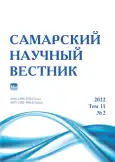Taxonomic diversity of Brassicaceae in the Samara-Ulyanovsk Volga Region
- Authors: Ivanova A.V.1, Kostina N.V.1, Aristova M.A.1
-
Affiliations:
- Institute of Ecology of the Volga River Basin of the Russian Academy of Sciences - Branch of the Samara Federal Research Center of the Russian Academy of Sciences
- Issue: Vol 11, No 2 (2022)
- Pages: 57-64
- Section: Biological Sciences
- URL: https://journals.rcsi.science/2309-4370/article/view/109830
- DOI: https://doi.org/10.55355/snv2022112108
- ID: 109830
Cite item
Full Text
Abstract
In the flora of the Samara-Ulyanovsk Volga region, the Brassicaceae family is one of the leading ones. It is of interest to study the composition of the genera of this family at the level of the territory of the entire Samara-Ulyanovsk Volga region, as well as the physiographic regions included in it. It helps to understand whether there are local features in the composition of the cruciferous flora and what they are. Two natural zones are distinguished in the study area: forest-steppe and steppe; four provinces and 15 physical-geographic regions. In this paper, we consider in more detail 7 floras, they are described most fully. All of them are located in the forest-steppe zone. In the spectra of flora families of the considered physiographic regions, the Brassicaceae family is located on the 4th–5th place. In the spectrum of the adventive fraction of the flora, it rises to the 2nd–3rd position, and in the native fraction it falls to the 7th–9th place. The composition of the complete flora of cruciferous plants throughout the territory of the Samara-Ulyanovsk Volga region contains 40 genera and 89 species. It is not possible to unambiguously single out the head part in the generic spectrum, concentrating in itself a significant part of the flora species of this family. The most numerous genera are Rorippa, Lepidium and Alyssum. The species representation of these genera, as well as those of slightly smaller weight (Cardamine, Erysimum and Sisymbrium), does not differ in the considered physiographic regions. An exception is the genus Alyssum, whose representatives are confined to limestone and chalk substrates, which are not common in all areas. The Brassicaceae family has a fairly wide ecological spectrum; it includes species that grow in different ecotopes.
Full Text
##article.viewOnOriginalSite##About the authors
Anastasia Viktorovna Ivanova
Institute of Ecology of the Volga River Basin of the Russian Academy of Sciences - Branch of the Samara Federal Research Center of the Russian Academy of Sciences
Email: nastia621@yandex.ru
candidate of biological sciences, researcher of Phytodiversity and Phytocoenology Problems Laboratory
Russian Federation, TogliattiNatalya Viktorovna Kostina
Institute of Ecology of the Volga River Basin of the Russian Academy of Sciences - Branch of the Samara Federal Research Center of the Russian Academy of Sciences
Email: knva2009@yandex.ru
doctor of biological sciences, head of Ecosystems Modeling and Management Laboratory
Russian Federation, TogliattiMargarita Alekseevna Aristova
Institute of Ecology of the Volga River Basin of the Russian Academy of Sciences - Branch of the Samara Federal Research Center of the Russian Academy of Sciences
Author for correspondence.
Email: margo.aristova2016@yandex.ru
junior researcher of Ecosystems Modeling and Management Laboratory
Russian Federation, TogliattiReferences
- Хохряков А.П. Основные типы флористических спектров Средней России // Флористические исследования в Центральной России: мат-лы науч. конф. «Флора Центральной России» (Липецк, 1-3 февраля 1995 г.) / под ред. В.Н. Тихомирова. М., 1995. С. 12-16.
- Хохряков А.П. Таксономические спектры и их роль в сравнительной флористике // Ботанический журнал. 2000. Т. 85, № 5. С. 1-11.
- Иванова А.В., Костина Н.В., Розенберг Г.С., Саксонов С.В. Семейственные спектры флор территории Волжского бассейна // Ботанический журнал. 2016. Т. 101, № 9. С. 1042-1055. doi: 10.1134/S0006813616090040.
- Иванова А.В., Костина Н.В., Васюков В.М. Таксономическое разнообразие семейства Fabaceae на территории Самаро-Ульяновского Поволжья // Экосистемы. 2020. № 23 (53). С. 32-47. doi: 10.37279/2414-4738-2020-23-32-47.
- Иванова А.В., Костина Н.В., Лысенко Т.М., Козловская О.В. Особенности флоры Мелекесско-Ставропольского физико-географического района // Самарский научный вестник. 2017. № 4 (21). С. 47-53. doi: 10.17816/snv201764109.
- Иванова А.В., Костина Н.В., Аристова М.А. Особенности таксономических спектров флор лесостепной части Самаро-Ульяновского Поволжья // Экосистемы. 2019. № 18 (48). С. 14-23.
- Саксонов С.В. Самаролукский флористический феномен. М.: Наука, 2006. 263 с.
- Физико-географическое районирование Среднего Поволжья / под ред. А.В. Ступишина. Казань: Изд-во Казанского ун-та, 1964. 173 с.
- Камелин Р.В. География растений: учеб. пособие. СПб.: Изд-во ВВМ, 2018. 306 с.
- Аристова М.А., Розенберг Г.С., Кудинова Г.Э., Розенберг А.Г., Иванова А.В., Васюков В.М., Костина Н.В., Саксонов С.В. База данных «Флористические описания локальных участков Самарской и Ульяновской областей» (FD SUR). Св-во о рег. базы данных RUS 2018621983 12.11.2018.
- Сенатор С.А., Васюков В.М. Конспект чужеродных растений Среднего Поволжья // Фиторазнообразие Восточной Европы. 2019. Т. XIII, № 4. С. 353-396. doi: 10.24411/2072-8816-2019-10057.
- Сосудистые растения Самарской области: учеб. пособие / под ред. А.А. Устиновой и Н.С. Ильиной. Самара: ООО «ИПК «Содружество». 2007. 400 с.
- Иванова А.В., Костина Н.В., Аристова М.А. Зависимость таксономических параметров флор от размеров выборки // Известия Саратовского университета. Новая серия. Серия: Химия. Биология. Экология. 2020. Т. 20, № 4. С. 404-416.
Supplementary files









